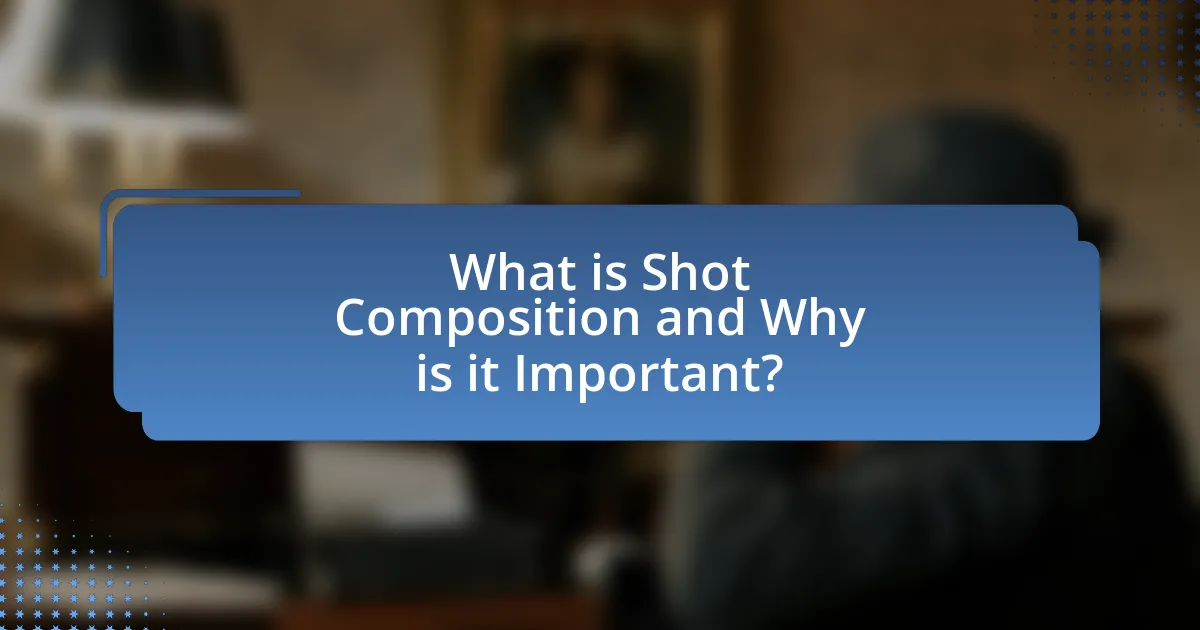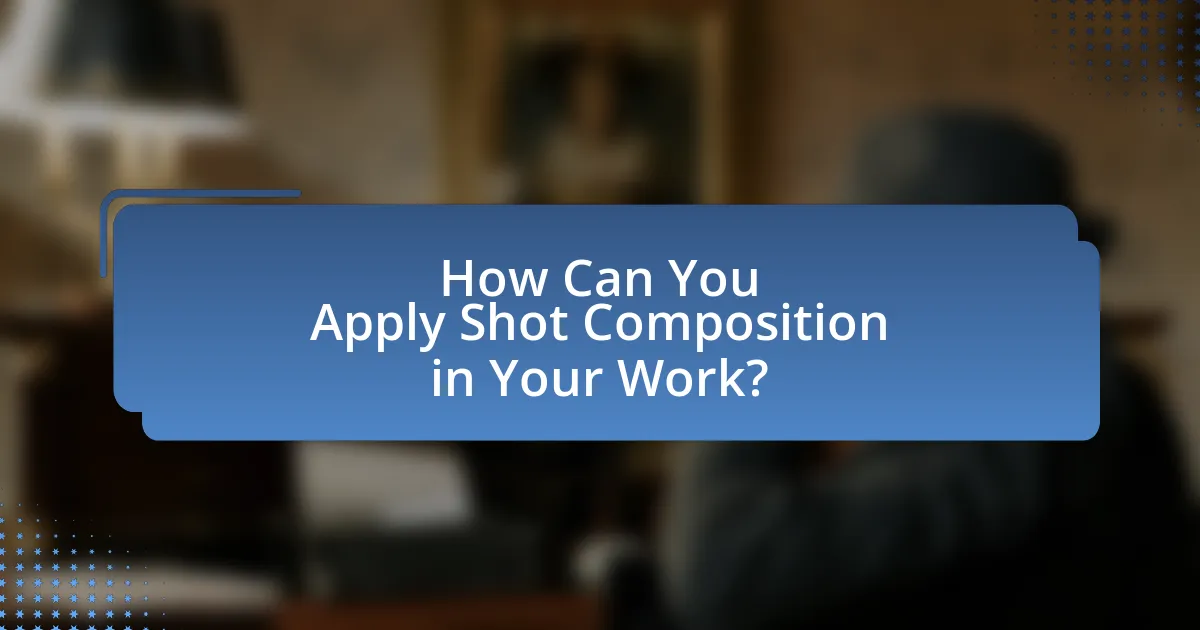Shot composition is the arrangement of visual elements within a frame in photography and film, crucial for influencing storytelling and viewer perception. This article explores the significance of shot composition, detailing its impact on narrative engagement through techniques such as the rule of thirds, framing, leading lines, and depth. Key elements of shot composition are examined, including how angles and perspectives shape emotional responses. Additionally, common mistakes to avoid and practical tips for improving composition skills are provided, along with resources for further learning. Understanding these principles is essential for creating visually compelling narratives that effectively communicate intended messages.

What is Shot Composition and Why is it Important?
Shot composition refers to the arrangement of visual elements within a frame in photography or film, influencing how a story is perceived. It is important because effective shot composition guides the viewer’s attention, establishes mood, and conveys meaning, ultimately enhancing storytelling. For instance, the rule of thirds, a fundamental principle of shot composition, suggests placing key elements along imaginary lines to create balance and interest, which has been shown to improve viewer engagement in visual media.
How does shot composition influence storytelling?
Shot composition significantly influences storytelling by shaping the viewer’s perception and emotional response to the narrative. Effective shot composition utilizes elements such as framing, angles, and depth to guide the audience’s focus, establish context, and convey character relationships. For instance, a close-up shot can evoke intimacy or tension, while a wide shot can provide context and scale, impacting how the story is understood. Research indicates that visual storytelling techniques, including shot composition, can enhance audience engagement and comprehension, as demonstrated in studies on film analysis and viewer reactions.
What are the key elements of shot composition?
The key elements of shot composition include framing, rule of thirds, balance, leading lines, depth, and perspective. Framing involves how subjects are positioned within the shot to guide the viewer’s attention. The rule of thirds suggests dividing the frame into a grid to place points of interest along the lines or intersections, enhancing visual appeal. Balance refers to distributing visual weight within the frame to create harmony. Leading lines direct the viewer’s eye towards the subject, while depth adds dimension, making the shot more engaging. Perspective influences how the viewer perceives the scene, affecting emotional impact. These elements are foundational in creating effective visual storytelling in photography and cinematography.
How does shot composition affect audience perception?
Shot composition significantly influences audience perception by guiding their emotional response and focus within a scene. Effective shot composition utilizes elements such as framing, angle, and depth to convey meaning and evoke feelings. For instance, a close-up shot can create intimacy and highlight a character’s emotions, while a wide shot can establish context and scale, affecting how viewers interpret the narrative. Research indicates that specific compositional techniques, like the rule of thirds, enhance visual engagement and comprehension, thereby shaping audience reactions.
What are the fundamental principles of shot composition?
The fundamental principles of shot composition include framing, rule of thirds, balance, leading lines, and depth. Framing involves using elements within the scene to create a visual boundary, guiding the viewer’s focus. The rule of thirds suggests dividing the frame into a grid of nine equal parts, placing key subjects along these lines or their intersections to create visual interest. Balance refers to the distribution of visual weight in a shot, ensuring that no single element overwhelms the composition. Leading lines are natural lines within the scene that direct the viewer’s eye toward the subject, enhancing depth and perspective. Lastly, depth can be achieved through layering elements in the foreground, middle ground, and background, creating a three-dimensional feel in a two-dimensional medium. These principles are widely recognized in photography and cinematography, as they enhance storytelling by effectively guiding viewer perception and engagement.
What role does framing play in shot composition?
Framing plays a crucial role in shot composition by determining how subjects are visually presented within the frame, influencing audience perception and emotional response. Effective framing guides the viewer’s attention, establishes context, and conveys meaning by highlighting specific elements while excluding others. For instance, the use of close-ups can create intimacy, while wide shots can establish a sense of scale or isolation. Studies in visual storytelling, such as those by Bordwell and Thompson in “Film Art: An Introduction,” demonstrate that framing choices significantly affect narrative interpretation and viewer engagement.
How do angles and perspectives impact shot composition?
Angles and perspectives significantly influence shot composition by altering the viewer’s perception and emotional response to the scene. Different angles, such as high, low, or eye-level, can create varying levels of intimacy, power dynamics, or tension. For instance, a low angle can make a subject appear dominant or imposing, while a high angle can evoke vulnerability or insignificance. Perspectives, including wide shots or close-ups, further shape the narrative by controlling the amount of information presented and guiding the audience’s focus. Research in visual storytelling indicates that these compositional choices directly affect audience engagement and interpretation, as demonstrated in studies analyzing viewer reactions to different framing techniques.

What Techniques Can Enhance Shot Composition?
Techniques that can enhance shot composition include the rule of thirds, leading lines, framing, and depth. The rule of thirds involves dividing the frame into a grid of nine equal parts and placing key elements along these lines or at their intersections, which creates balance and interest. Leading lines guide the viewer’s eye toward the subject, enhancing focus and depth. Framing uses elements within the scene to create a ‘frame’ around the subject, drawing attention and adding context. Depth can be achieved by including foreground, middle ground, and background elements, which adds dimension and makes the shot more engaging. These techniques are widely recognized in photography and cinematography for their effectiveness in creating visually compelling images.
How can the rule of thirds improve shot composition?
The rule of thirds improves shot composition by guiding the placement of subjects and elements within a frame to create a more balanced and engaging image. This compositional technique divides an image into nine equal parts using two horizontal and two vertical lines, encouraging photographers to position key elements along these lines or at their intersections. Research indicates that images adhering to the rule of thirds are perceived as more aesthetically pleasing, as they draw the viewer’s eye naturally across the frame, enhancing visual interest and storytelling.
What is the rule of thirds and how is it applied?
The rule of thirds is a compositional guideline that suggests dividing an image into nine equal parts using two horizontal and two vertical lines, placing key elements along these lines or at their intersections. This technique enhances visual interest and balance in photography and visual arts by guiding the viewer’s eye to focal points, rather than centering the subject. For example, placing a horizon along the top or bottom third line creates a more dynamic image than centering it. This principle is widely used in various forms of visual storytelling, including photography, film, and painting, to create more engaging and aesthetically pleasing compositions.
What are the benefits of using the rule of thirds?
The rule of thirds enhances visual composition by guiding the placement of subjects and elements within a frame. This technique divides an image into nine equal parts using two horizontal and two vertical lines, creating focal points at their intersections. By positioning key elements along these lines or at their intersections, photographers and filmmakers can achieve a more balanced and engaging composition. Studies in visual perception indicate that images aligned with the rule of thirds are more aesthetically pleasing and draw viewers’ attention more effectively, as they align with natural human tendencies to seek balance and harmony in visual stimuli.
What is the significance of leading lines in shot composition?
Leading lines are significant in shot composition because they guide the viewer’s eye toward the main subject, creating a sense of depth and perspective. By using natural or architectural elements, such as roads, fences, or rivers, photographers and filmmakers can enhance the visual narrative and draw attention to focal points within the frame. This technique not only improves the overall aesthetic appeal but also helps convey emotions and themes, as evidenced by studies showing that images utilizing leading lines are often perceived as more engaging and dynamic.
How do leading lines guide the viewer’s eye?
Leading lines guide the viewer’s eye by creating a visual pathway that directs attention toward the main subject of an image. These lines can be natural elements, such as roads or rivers, or man-made structures, like fences or buildings, that draw the viewer’s gaze along their trajectory. Research in visual perception indicates that humans are naturally inclined to follow lines and shapes, which enhances the composition’s effectiveness by establishing depth and perspective. This technique not only emphasizes the focal point but also adds a sense of movement and dynamism to the composition, making the overall image more engaging.
What are examples of leading lines in visual storytelling?
Examples of leading lines in visual storytelling include roads, pathways, rivers, and architectural elements like bridges or fences. These lines guide the viewer’s eye toward the main subject or focal point of the image, enhancing the narrative. For instance, a photograph of a winding road can create a sense of journey, while a river leading to a mountain can evoke feelings of adventure and exploration. Leading lines are effective because they create depth and perspective, drawing attention to the intended subject and establishing a visual connection within the composition.

How Can You Apply Shot Composition in Your Work?
To apply shot composition in your work, focus on the arrangement of visual elements within the frame to enhance storytelling. Effective shot composition involves using techniques such as the rule of thirds, leading lines, and framing to guide the viewer’s eye and create a balanced image. For instance, the rule of thirds suggests placing key subjects along imaginary lines that divide the frame into thirds, which can lead to more engaging and dynamic visuals. Research indicates that well-composed shots can significantly impact audience engagement and emotional response, as seen in studies analyzing viewer preferences in cinematography.
What are some common mistakes to avoid in shot composition?
Common mistakes to avoid in shot composition include neglecting the rule of thirds, failing to consider the background, and not maintaining proper focus. Neglecting the rule of thirds can lead to unbalanced and less engaging images, as this guideline helps create visual interest by placing subjects along intersecting lines. Failing to consider the background can result in distractions that detract from the main subject, making the shot less effective. Not maintaining proper focus can cause important elements to appear blurry, undermining the clarity and impact of the composition. These mistakes can significantly diminish the overall quality of visual storytelling.
How can poor framing affect the overall message?
Poor framing can significantly distort the overall message by misguiding the audience’s perception and interpretation of the subject. When a shot is poorly framed, it may omit essential context or create distractions that detract from the intended focus, leading to confusion or miscommunication. For instance, a study by the University of Southern California found that viewers’ emotional responses and understanding of a narrative can be altered by framing choices, demonstrating that effective framing is crucial for conveying the desired message accurately.
What are the consequences of neglecting composition techniques?
Neglecting composition techniques leads to ineffective visual storytelling, resulting in a disorganized narrative that fails to engage the audience. Poor composition can create confusion, distract from the subject, and diminish emotional impact, ultimately weakening the overall message. For instance, studies in visual communication indicate that well-composed shots enhance viewer retention and emotional response, while poorly composed images can lead to viewer disengagement and misunderstanding of the intended message.
What practical tips can improve your shot composition skills?
To improve shot composition skills, utilize the rule of thirds by dividing the frame into a 3×3 grid and placing key elements along the lines or at their intersections. This technique enhances visual interest and balance, as studies in visual perception indicate that viewers naturally focus on these points. Additionally, experiment with leading lines to guide the viewer’s eye toward the subject, which can create depth and context in the shot. Using foreground elements can also add layers to the composition, making it more engaging. Lastly, consider the framing and background to eliminate distractions, ensuring that the subject stands out clearly.
How can you practice shot composition effectively?
To practice shot composition effectively, photographers should utilize techniques such as the rule of thirds, leading lines, and framing. The rule of thirds involves dividing the frame into a 3×3 grid and placing key elements along these lines or at their intersections, which enhances visual interest. Leading lines guide the viewer’s eye toward the subject, creating depth and perspective. Framing involves using elements within the scene to create a ‘frame’ around the subject, drawing attention and adding context. These techniques are supported by studies in visual perception, which indicate that well-composed images are more engaging and easier for viewers to process.
What resources are available for learning shot composition?
Books, online courses, and video tutorials are key resources for learning shot composition. Notable books include “The Five C’s of Cinematography” by Joseph V. Mascelli, which outlines essential principles of visual storytelling, and “Cinematography: Theory and Practice” by Blain Brown, which provides comprehensive insights into shot composition techniques. Online platforms like MasterClass and Coursera offer courses taught by industry professionals, covering various aspects of shot composition. Additionally, YouTube channels such as Film Riot and Lessons from the Screenplay provide practical examples and breakdowns of shot composition in popular films, making them accessible for learners.


